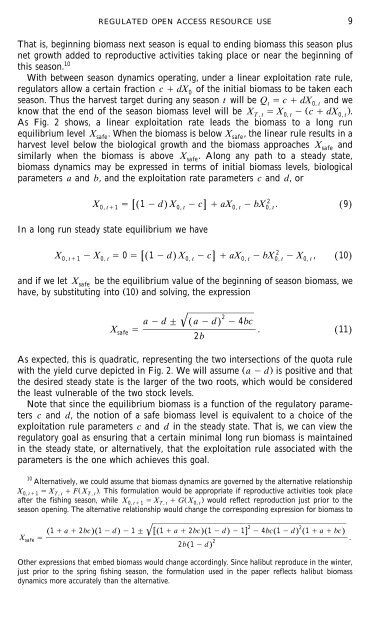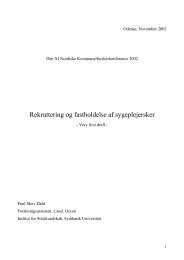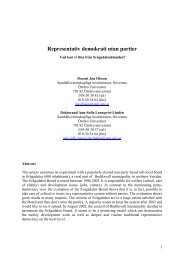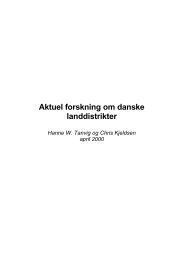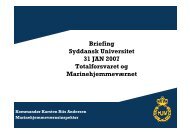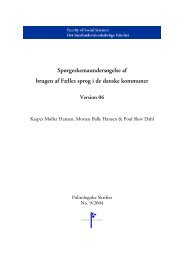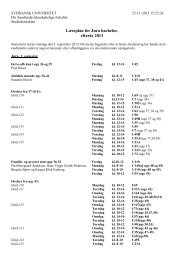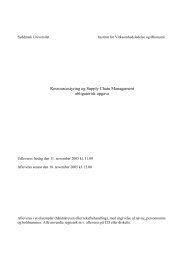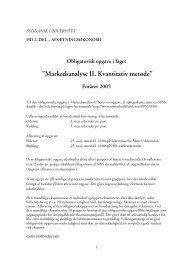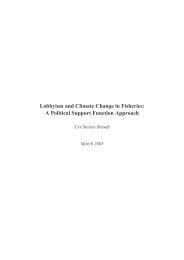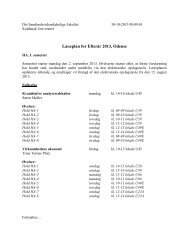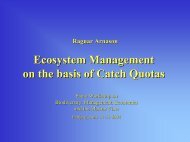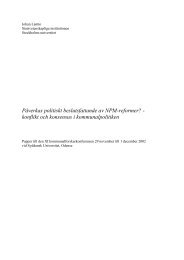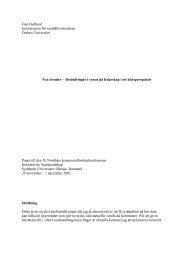A Model of Regulated Open Access Resource Use
A Model of Regulated Open Access Resource Use
A Model of Regulated Open Access Resource Use
You also want an ePaper? Increase the reach of your titles
YUMPU automatically turns print PDFs into web optimized ePapers that Google loves.
REGULATED OPEN ACCESS RESOURCE USE 9<br />
That is, beginning biomass next season is equal to ending biomass this season plus<br />
net growth added to reproductive activities taking place or near the beginning <strong>of</strong><br />
this season. 10<br />
With between season dynamics operating, under a linear exploitation rate rule,<br />
regulators allow a certain fraction c dX0<br />
<strong>of</strong> the initial biomass to be taken each<br />
season. Thus the harvest target during any season t will be Qt<br />
c dX0, t and we<br />
know that the end <strong>of</strong> the season biomass level will be X X Ž c dX .<br />
T , t 0, t 0, t .<br />
As Fig. 2 shows, a linear exploitation rate leads the biomass to a long run<br />
equilibrium level X safe. When the biomass is below X safe, the linear rule results in a<br />
harvest level below the biological growth and the biomass approaches Xsafe<br />
and<br />
similarly when the biomass is above X safe. Along any path to a steady state,<br />
biomass dynamics may be expressed in terms <strong>of</strong> initial biomass levels, biological<br />
parameters a and b, and the exploitation rate parameters c and d, or<br />
Ž . Ž .<br />
2<br />
X0, t1 1d X0, tc aX0, t bX 0, t. 9<br />
In a long run steady state equilibrium we have<br />
Ž . Ž .<br />
2<br />
X0, t1 X0, t 0 1 d X0, t c aX0, t bX0, t X 0, t, 10<br />
and if we let Xsafe<br />
be the equilibrium value <strong>of</strong> the beginning <strong>of</strong> season biomass, we<br />
have, by substituting into Ž 10.<br />
and solving, the expression<br />
'<br />
2<br />
a d Ž a d.<br />
4bc<br />
Xsafe<br />
. Ž 11.<br />
2b<br />
As expected, this is quadratic, representing the two intersections <strong>of</strong> the quota rule<br />
with the yield curve depicted in Fig. 2. We will assume Ž a d.<br />
is positive and that<br />
the desired steady state is the larger <strong>of</strong> the two roots, which would be considered<br />
the least vulnerable <strong>of</strong> the two stock levels.<br />
Note that since the equilibrium biomass is a function <strong>of</strong> the regulatory parameters<br />
c and d, the notion <strong>of</strong> a safe biomass level is equivalent to a choice <strong>of</strong> the<br />
exploitation rule parameters c and d in the steady state. That is, we can view the<br />
regulatory goal as ensuring that a certain minimal long run biomass is maintained<br />
in the steady state, or alternatively, that the exploitation rule associated with the<br />
parameters is the one which achieves this goal.<br />
10 Alternatively, we could assume that biomass dynamics are governed by the alternative relationship<br />
X X FŽ X .<br />
0, t1 T , t T, t . This formulation would be appropriate if reproductive activities took place<br />
after the fishing season, while X X GŽ X .<br />
0, t1 T , t 0, t would reflect reproduction just prior to the<br />
season opening. The alternative relationship would change the corresponding expression for biomass to<br />
Ž 1a2bc.Ž 1 d. 1 'Ž 1 a 2bc.Ž 1 d. 1 2 4bcŽ 1 d. 2<br />
Ž 1 a bc.<br />
Xsafe .<br />
2<br />
2bŽ 1 d.<br />
Other expressions that embed biomass would change accordingly. Since halibut reproduce in the winter,<br />
just prior to the spring fishing season, the formulation used in the paper reflects halibut biomass<br />
dynamics more accurately than the alternative.


